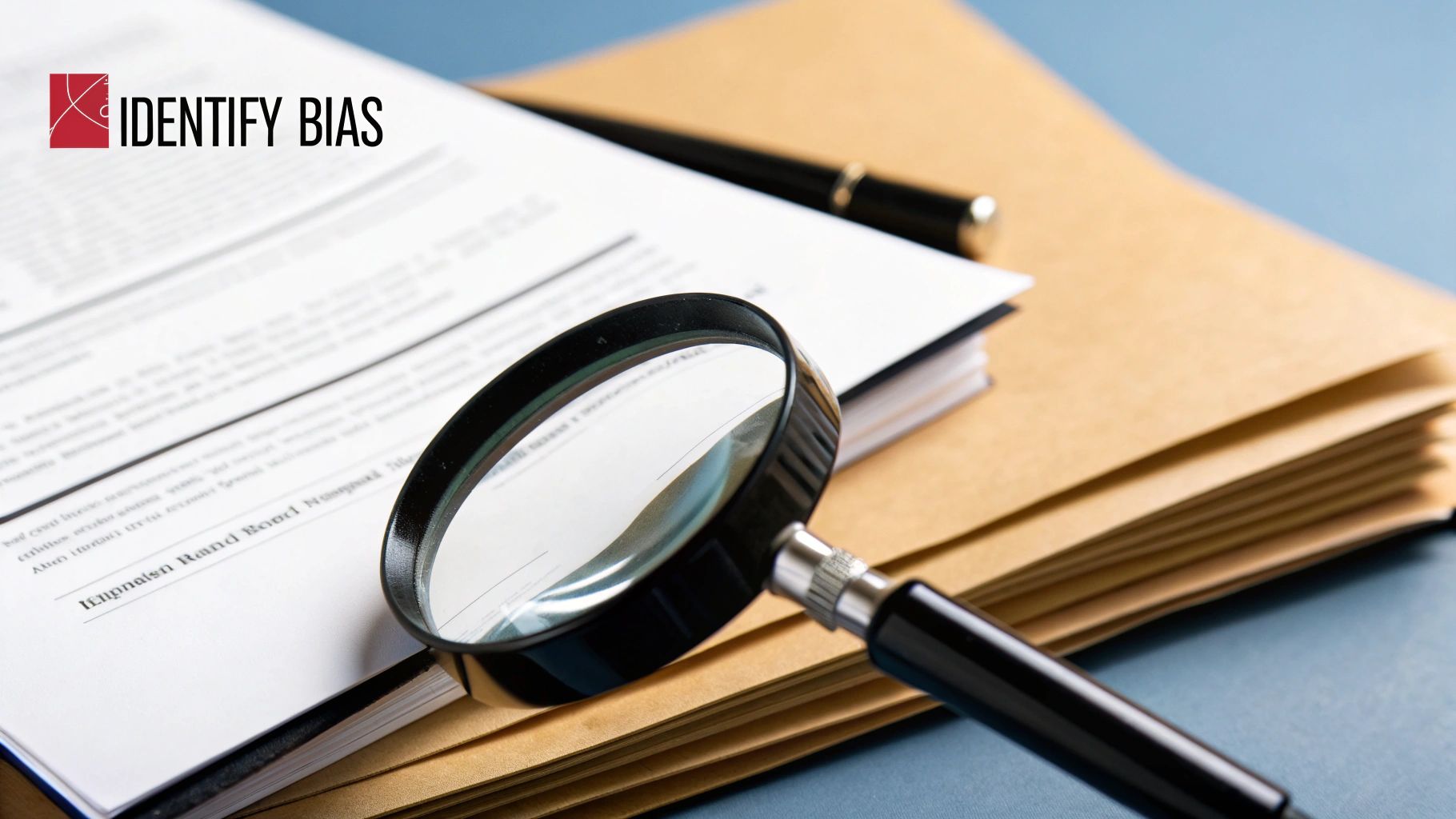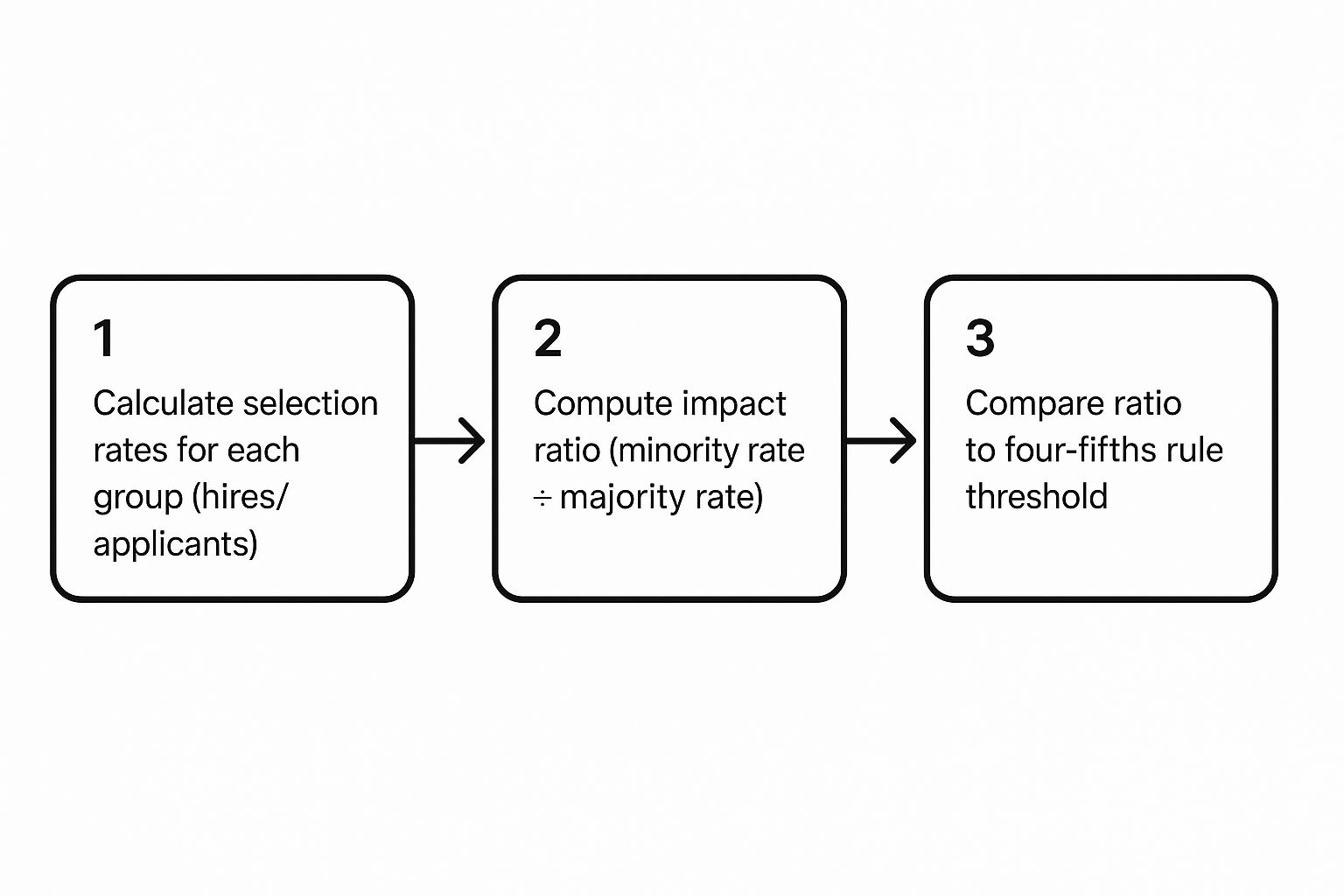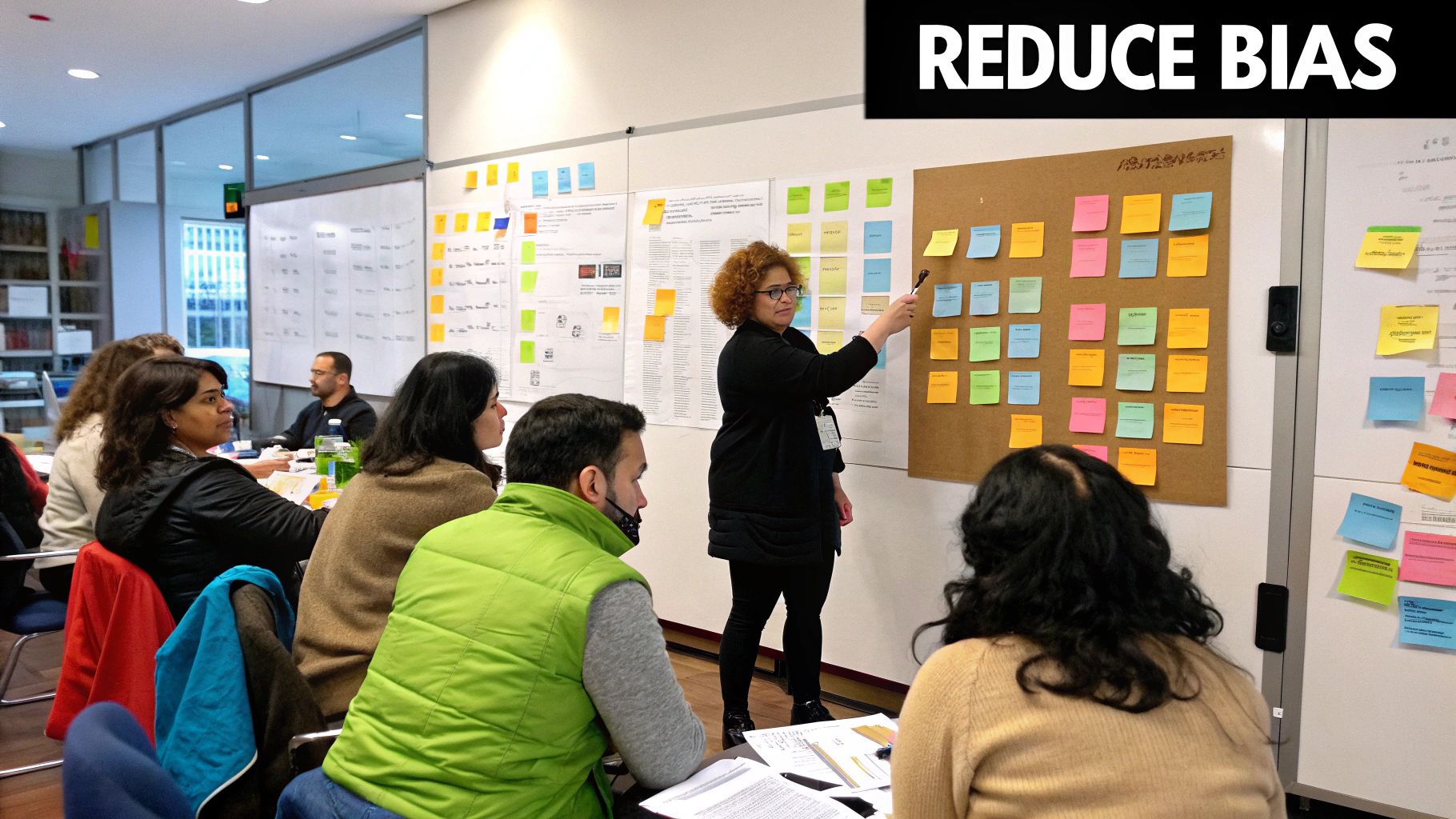Understanding Adverse Impact in Fair Hiring
Picture this: you’ve set up a hiring filter that’s meant to find the absolute best candidates. But without you realising it, that same filter is systematically blocking talented people from a certain demographic. That, in a nutshell, is adverse impact. It’s when your employment practices look fair on the surface but end up creating a lopsided, negative outcome for a protected group.
What Is Adverse Impact In Hiring?

Adverse impact is one of the most subtle yet serious challenges in recruitment. It isn’t about deliberate, malicious discrimination; it’s about the unintended side effects of your hiring process. Think of it like using a fishing net. You might just want to catch fish, but if the holes in your net are a specific size, you could accidentally let one species swim free while catching another entirely.
This kind of bias often creeps in through what seem like perfectly reasonable requirements. For instance, a job post might require a degree from a small, exclusive list of elite universities. The intention might be to attract top-tier talent, but this one rule could automatically disqualify countless applicants from less privileged backgrounds. Likewise, a cognitive skills test that hasn’t been properly validated for fairness could unintentionally give an advantage to one cultural group over others.
Distinguishing Intentional vs. Unintentional Bias
It’s absolutely critical to understand the line between direct discrimination and adverse impact. One is about intent, while the other is all about the outcome.
To put it simply, adverse impact is about the effect of a policy, not the motivation behind it. A company can have the best of intentions and still maintain processes that build systemic barriers. This is precisely why organisations need to look past intent and start analysing the real-world results of their hiring methods.
Let’s break it down in a quick comparison table.
| Concept | Description |
|---|---|
| Intentional Discrimination | This is direct and deliberate. It involves treating someone differently based on a protected characteristic like gender, religion, or caste. For example, explicitly refusing to hire women for a particular role. |
| Unintentional Bias | This is indirect. It happens when a neutral-seeming policy negatively affects a protected group disproportionately. For example, a strength test that screens out far more female applicants than male ones for a desk job where that strength isn’t needed. |
This distinction is the bedrock of fair hiring. Once an imbalance is spotted, the focus shifts to proving that the practice is genuinely fair and necessary for the job.
The Legal and Ethical Stakes of Fair Hiring

Alright, we’ve covered the “what.” Now let’s get into the why. Understanding why adverse impact must be at the top of your agenda is crucial for any modern organisation. The stakes are incredibly high, involving a tough mix of legal obligations, ethical principles, and very real business risks that define today’s corporate world in India and beyond.
Fair hiring isn’t just about ticking a compliance box; it’s the foundation of a business that people trust and want to work for. When you ignore systemic biases in your recruitment process, it doesn’t just feel wrong—it leads to real trouble. We’re talking about everything from costly legal battles and a damaged reputation to the massive missed opportunity of overlooking brilliant, diverse talent that could have taken your company to the next level.
The Foundation of Corporate Responsibility
In India, the push for fair hiring comes from all sides: constitutional mandates, labour laws, and affirmative action policies. Together, these create a clear expectation that businesses must actively work to provide equal opportunities.
The core idea is simple and universal: every candidate deserves a shot based on their skills and what they can bring to the table, not where they come from. When your hiring process, even accidentally, puts up barriers for certain groups, you’re undermining that fundamental principle. This is exactly why companies are being held accountable for the results of their hiring, not just their good intentions.
The real-world consequences of ignoring adverse impact are severe. Beyond the courtroom, a reputation for unfair practices can make it nearly impossible to attract top-tier talent, alienate customers, and erode employee morale and trust from within.
Unpacking Systemic Disparities in India
A closer look at the data in India reveals some deep-rooted imbalances in employment, particularly around gender and caste, which often show up as adverse impact. For example, fresh data from the Ministry of Statistics and Programme Implementation shows that as of 2022-23, female labour force participation is stuck at around 20%, while it’s over 70% for men. This kind of structural gap almost inevitably leads to adverse impact in hiring.
Similarly, while Scheduled Castes/Tribes represent a significant part of the population, they are still underrepresented in formal sector jobs. This highlights the exact kind of patterns that Indian labour laws and affirmative action policies are trying to fix. For a deeper dive, you can find more insights about disparate impact liability and its employer implications on ebglaw.com.
How to Measure Adverse Impact with the Four-Fifths Rule
To get a real handle on adverse impact, you first need a solid way to measure it. The go-to method for this is the Four-Fifths Rule, often called the 80% Rule. Don’t let the name fool you; it isn’t a rigid legal command. Instead, think of it as a practical “rule of thumb” that HR teams use for a quick health check on their hiring practices.
It’s your early warning system. It doesn’t automatically prove discrimination is happening, but it does shine a spotlight on parts of your hiring funnel that might be creating unfair disadvantages, telling you exactly where to look closer. The idea behind it is straightforward: the hiring rate for any protected group of candidates should be at least 80% (or four-fifths) of the rate for the group that gets hired most often.
This infographic breaks down the simple, three-step process for putting the rule into action. As you can see, it’s all about calculating the selection rates for different groups, figuring out the impact ratio, and then checking that figure against the 80% benchmark.
As you can see, it’s all about calculating the selection rates for different groups, figuring out the impact ratio, and then checking that figure against the 80% benchmark.
Breaking Down the Calculation
Let’s walk through an example to see how this works in the real world. Imagine your company is hiring a new team of software developers. You get applications from 200 men and 100 women.
- Calculate the Selection Rate for Each Group: This is just the percentage of applicants from a specific group who end up getting a job offer.
- Men: You hire 20 of the 200 male applicants. So, the selection rate is 20 / 200 = 10%.
- Women: You hire 5 of the 100 female applicants. Their selection rate is 5 / 100 = 5%.
- Identify the Group with the Highest Rate: In our scenario, men have the higher selection rate at 10%. This group now becomes our benchmark for comparison.
- Calculate the Impact Ratio: Next, you divide the selection rate of the group with the lower rate (women) by the selection rate of the group with the higher rate (men).Impact Ratio = (Selection Rate of Minority Group) / (Selection Rate of Majority Group) In our example: 5% / 10% = 0.50 or 50%
- Compare to the Four-Fifths Rule: The last step is to see if your impact ratio clears the 80% hurdle. Since our calculated ratio of 50% is well below 80%, this hiring process has failed the Four-Fifths Rule.
This result is a clear signal that adverse impact might be affecting female applicants in your pipeline.
What Failing the Rule Really Means
It’s really important to understand that failing the Four-Fifths Rule isn’t an admission of guilt or proof of discrimination. Think of it as a statistical red flag. It’s a sign that you need to dig deeper and validate the hiring practice that’s causing this imbalance. Is that particular assessment, interview style, or job requirement truly essential for performing the role? And more importantly, is there a less discriminatory alternative that could achieve the same goal?
In India, while not a strict legal mandate, this rule provides a vital conceptual framework for many organisations, particularly in the IT and corporate sectors that are adopting more structured and global talent practices. It acts as a key internal benchmark for auditing the fairness of recruitment and promotion decisions. For instance, if male candidates are hired 50% of the time but female candidates only 25%, the calculation (0.25 / 0.50 = 0.5) reveals a 50% selection rate, flagging a potential bias that warrants immediate investigation. If you want to dive deeper, you can learn more about the steps to calculating your adverse impact from Berkshire Associates.
Hidden Causes of Adverse Impact in Your Hiring Funnel

So, now you know how to measure adverse impact. The next challenge is finding out where it’s hiding in your process. More often than not, it comes from well-intentioned practices that accidentally filter out perfectly qualified people. These hidden issues can pop up at any stage, from the moment a job is posted to the final handshake.
Identifying these problem areas is your first real step toward building a hiring system that’s genuinely fair. Let’s dig into some of the most common—and often unnoticed—sources of bias that might be creating imbalances in your talent pipeline right now.
Overly Restrictive Job Descriptions
The problem often begins before you’ve even seen a single CV. Job descriptions packed with overly specific or flat-out unnecessary requirements are a major source of adverse impact.
Think about a role that lists “must have a degree from a top-tier university” as a non-negotiable. This single line immediately disqualifies a huge pool of talented candidates who might have attended local or less-known institutions but have the exact skills you need. In the same way, demanding 10+ years of experience for a job that someone with five years of solid performance could handle can disproportionately screen out younger, highly capable applicants.
These criteria often serve as weak proxies for skill instead of measuring it directly, creating barriers where there shouldn’t be any.
Unvalidated Pre-employment Tests
Pre-employment tests can be fantastic tools, but only if they’re fair and actually relevant to the job. Using a cognitive or skills assessment that hasn’t been properly validated for a specific role is a recipe for introducing bias.
A test is considered “validated” only when there’s solid proof it accurately predicts job performance and doesn’t unfairly penalise any specific demographic group. Without that validation, a test might just be measuring how good someone is at taking that particular test, not how well they can do the job.
For instance, giving a complex English verbal reasoning test for a coding position might weed out brilliant programmers who aren’t native English speakers. The test isn’t measuring coding ability; it’s measuring language skills, which might not even be a core job requirement. This creates significant adverse impact without doing anything to improve the quality of your hires.
Biased Sourcing and Unstructured Interviews
Where you search for candidates has a direct impact on who you find. If you only rely on employee referrals or tap into the same few professional networks, you’re likely to end up with a very homogenous talent pool. If your current team isn’t very diverse, your referral programme will probably just replicate that same dynamic. It’s crucial to proactively expand your sourcing channels to reach different communities.
However, the most common culprit is probably the unstructured interview. When interviewers just go with their “gut feeling” and don’t use a standard set of questions and a scoring guide, unconscious bias runs the show. This can easily lead to decisions based on things like a shared background or a vague sense of “culture fit” rather than on the candidate’s actual ability to succeed in the role. Many organisations are now shifting their approach to be more candidate-centric; you can explore new strategies by learning about the future of hiring with reverse recruiting.
Actionable Strategies to Prevent Adverse Impact
Spotting adverse impact is one thing, but stopping it before it starts? That requires a deliberate, proactive game plan. Building a truly fair hiring process isn’t about applying a few quick fixes. It’s about weaving equity into the very fabric of your recruitment strategy, from the first sourcing outreach to the final offer.
This means moving beyond theory and getting your hands dirty. It’s about systematically tearing down the hidden, often unintentional, barriers that create hiring disparities. By focusing on concrete, evidence-based methods, your organisation can build a hiring framework that’s not just legally sound, but also far better at finding the best person for the job, no matter their background.
Let’s break down the essential strategies.
Audit and Refine Your Job Descriptions
The job description is your first handshake with a potential candidate, and it’s a minefield for unintentional bias. Puffy, vague, or exclusionary language can scare off brilliant people before they even think about applying. A thorough audit is your best first line of defence.
- Scrutinise every requirement. Ask the hard question: “Is this degree, skill, or specific year of experience really essential to do this job well?” Get good at separating the absolute must-haves from the nice-to-haves.
- Use inclusive language. Ditch the gender-coded jargon like “rockstar” or “dominant” which can subtly put off certain applicants. Instead, focus on neutral, skills-based language that clearly describes what the job entails.
- Eliminate unnecessary barriers. Things like requiring a degree from a specific elite university or an arbitrary 10 years of experience often have little to do with predicting success on the job, but they are notorious for creating adverse impact.
Implement Structured and Standardised Processes
Relying on “gut feelings” during interviews is one of the biggest entry points for unconscious bias. When you implement structured processes, you ensure every single candidate gets the same fair shot, evaluated against the same objective, job-related criteria.
A structured interview process is your best defence against the influence of unconscious bias. By using a consistent set of questions and a predefined scoring rubric for every candidate, you shift the focus from personal affinity to demonstrated capability, significantly reducing the risk of adverse impact.
And this structure needs to go beyond the interview itself. It’s absolutely non-negotiable to validate all your pre-employment tests. An assessment is only helpful if it actually predicts job performance and has been proven not to disproportionately screen out any protected group. Without that validation, a test isn’t just a tool; it’s a potential legal liability.
Diversify Sourcing and Train Your Team
You can’t hire diverse talent if they aren’t in your candidate pipeline to begin with. If you only rely on employee referrals or the same old professional networks, you’re likely to just keep hiring more of the same. You have to actively broaden your horizons by sourcing from a wide range of channels—think different job boards, community organisations, and a wider variety of universities. Embracing diversity in hiring is a strategic imperative that needs intentional effort.
Finally, consistent training on unconscious bias is crucial for everyone involved in hiring. This isn’t a one-and-done session. Regular training helps your hiring managers and interviewers recognise and challenge their own biases, leading to fairer, more objective decisions. When you pair this education with periodic adverse impact analyses, you create a powerful feedback loop. You can proactively monitor your hiring funnel, catch problems early, and make data-driven changes to keep your process fair and effective.
Why Fair Hiring Is a Competitive Advantage
Let’s move past the basics of risk management and compliance. It’s time to see that proactively tackling adverse impact is more than just avoiding legal headaches—it’s a genuine driver for strategic growth. This is about building a company that’s stronger, more creative, and more resilient right from the very beginning. The business case for equity is simply too strong to ignore.
When your hiring process is truly fair, it naturally attracts a much wider range of talent. This diversity of thought and experience is what fuels better problem-solving and sparks real creativity within your teams. Companies that actively build inclusive environments are just better positioned to understand their diverse customers and adapt to whatever the market throws at them.
From Compliance to Market Leadership
A solid reputation for fairness isn’t just a nice-to-have; it’s a major competitive advantage. It helps you pull in and keep the best people, especially since top performers are increasingly looking for workplaces with a strong ethical backbone. This, in turn, boosts morale and loyalty, which means less money spent on replacing people who leave.
Equity in hiring isn’t just a job for the HR department—it’s a core business strategy. When you dismantle those unintentional barriers, you unlock the full potential of the entire talent market. This leads directly to better company performance and a stronger brand.
Ultimately, preventing adverse impact solidifies your company’s status as an employer of choice. It sends a clear signal to the market that you’re a forward-thinking organisation, one that’s committed to both excellence and integrity. If you’re ready to build a team like that, our guide on how to hire top talent and accelerate recruitment has some valuable insights you might find useful.
Frequently Asked Questions
Getting to grips with the complexities of fair hiring can bring up a lot of questions. We’ve put together some straightforward answers to the queries we hear most often from HR professionals and business leaders about spotting and managing adverse impact.
Does Finding Adverse Impact Mean My Company Is Discriminating?
Not necessarily, no. Think of it this way: discovering that a hiring practice fails the Four-Fifths Rule is like a warning light on your car’s dashboard. It’s not proof of a total breakdown (or in this case, intentional discrimination), but it’s a clear statistical signal that something needs a closer look. Once that light is on, the responsibility shifts to you. It’s your cue to investigate and prove that the specific selection method is genuinely essential for performing the job, and that there isn’t a fairer, equally effective alternative available.
Can Adverse Impact Only Affect Women or Certain Castes?
That’s a common misconception, but no. Adverse impact can potentially affect any demographic group. While discussions in India often centre on historically disadvantaged groups based on gender or caste, the underlying principle of fairness applies universally. Any seemingly neutral policy can create an unintended barrier for a particular group. For example, consider these scenarios: A demanding physical strength test for a desk job could unintentionally screen out a higher percentage of female applicants compared to male applicants. Requiring prior experience with a very expensive, niche software could put talented candidates from lower-income backgrounds at a disadvantage, simply because they never had access to it. A proper analysis must always examine all relevant demographic groups to ensure your hiring process is truly equitable for everyone. At its heart, adverse impact is about ensuring equal opportunity. It’s a framework for checking if your hiring practices are accidentally putting up roadblocks for any group of people, no matter their background.
How Often Should We Conduct an Adverse Impact Analysis?
For most companies, running an analysis once a year for all major employment decisions like hiring, promotions, even layoffs is a solid best practice. It acts as a regular health check for your people processes. However, sometimes you’ll need to do it more often. If you’re hiring in large volumes or rolling out a new selection tool, like a skills assessment or a personality test, it’s wise to increase the frequency to quarterly. This helps you catch and fix potential issues early on, before they become a bigger problem.
Ready to build a hiring process that attracts top talent fairly and efficiently? Taggd specialises in Recruitment Process Outsourcing, helping you eliminate hidden biases and achieve your diversity goals. Learn how we can help.
